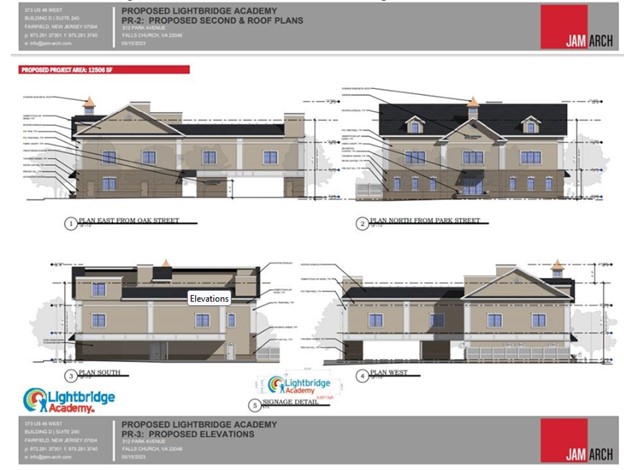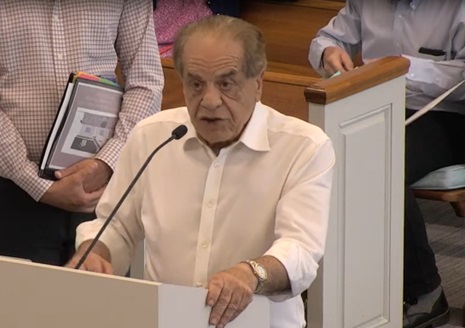Oak Place Variance Denied By The Board Of Zoning Appeals (3-1)
Oak Place variance request denied
During the meeting on October 12, 2023, the Board of Zoning Appeals (BZA) reviewed the variance request from Oak Park, LLC, to increase the lot coverage from the permitted 40% to 55% for the Oak Place daycare project. The BZA voted 3-1 to deny the variance request.
Background – support, concerns and impact of new T-Zone code
The Oak Place project is a by-right development in the transition zoned lot on the corner of North Oak Street and Park Avenue. Oak Park, LLC, purchased the two adjacent lots, totaling 15,625 sf (0.36 acres) and consolidated them to build a daycare for up to 180 children. More information may be found in our posts on this project, Oak Place.
Although Planning staff had recommended that the variance be granted, the Planning Commissioners tied (3-3) on whether to recommend that the BZA approve the variance. The discussion by the Planning Commissioners can be found here. The Architectural Advisory Board also voted to recommend that the variance be approved.
The BZA had postponed a vote on this project in September at the request of the developer to await the approval of the new Transition Zone Code. The new code would apply to these properties in January 2024, and would allow a lot coverage of 60% by right, that is, without the need to seek any permissions.
The project received support from its commercial neighbors, the Hilton Garden and the owner of the Econize properties on Park Avenue. However, the residential neighbors and St. James Catholic School had concerns about the parking and traffic and resulting safety issues for students.

Discussion
Making the case that 40% lot coverage is unreasonably restrictive
Andrew Painter, counsel for the Oak Place project, explained that according to the Code of Virginia, section 15.2-2309 Powers and duties of boards of zoning appeals, variance could be granted if:
- the code unreasonably restricts the utilization of the property, or
- granting the variance would alleviate a hardship due to a physical condition relating to the property.
He then proceeded to explain the difficulties of the small size of the lot, the requirement for two front setbacks as a corner lot, and that it was hemmed in by the Hilton garage so that there was no possibility of acquiring additional property adjacent to it.
Is the Mary Riley Styles Library variance a precedent to grant this variance?
Mr. Painter cited the variance given to the Mary Riley Styles library as precedence for granting variance in this case. The library received a variance to increase its lot coverage to 57% and is similarly a corner lot. He also referred to the new transition code that allowed a 60% coverage, signalling City Council’s public policy preference for increasing the maximum lot coverage beyond what is there today.
BZA member Keith Bartlett responded that the library is not like the Oak Place project. The library already had a wall within that setback and the BZA allowed them to extend the building to that wall. The library is a much-needed City facility with nowhere else to go. Other BZA members brought up the fact that the library had to be brought up to compliance with the Americans with Disabilities Act.
Does the building really have to be this big?
Mr. Painter argued that although there may be other uses for the property, the daycare use is “reasonable” and it is supported by the City’s Comprehensive Plan, that is one of the businesses they would like to have in the City. BZA member Keith Bartlett said that the City’s plan does not call for a childcare facility of that size. Mr. Painter replied that the daycare size was determined by market forces to be economically viable.
Members of the BZA questioned the architect regarding the design of the building and whether it was possible to have a smaller footprint. The developers responded that the design was limited by state regulations regarding daycare and the need for parking spaces for employees.
BZA member Gene Gresko pointed out that the owner bought these small lots with full knowledge of all the code requirements that they have now raised as hardships. The variance code says that the hardship should not be created by the applicant, yet it seemed the case here.
New vs. old Transition Zone code
The Oak Place project required only the lot coverage variance under the existing transition zone code. Under the new transition zone code, effective January 2024, the project would require a Special Use Permit (SUP) from City Council to allow a variance for the 15-foot setback on Park Avenue and one for commercial use exceeding 4,000 sf.
(BZA members wondered why the SUP process for seeking variance involved City Council rather than the BZA.)
The developers said they did not want to delay the project further. A new application would be needed if they were to apply under the new code, and a process involving City Council for an SUP would be lengthy. Robert Young, the developer and owner, also spoke briefly about his efforts on this project.
Final vote
BZA members Gene Gresko, Kristine Ward and Keith Bartlett did not feel the project should be able to pick and choose which aspects of different codes they should be allowed to follow. Under the current zoning code, the developers had not proven the lot coverage was unreasonably restrictive or caused hardship. Only the BZA chair, John Misleh, voted to approve the project. The BZA denied the request for a lot coverage variance by a 3-1 vote.
The developers now have the option to re-apply under the new transition zone code in January 2024.
References
- Board of Zoning Appeals meeting, October 12, 2023, https://fallschurch-va.granicus.com/player/clip/2445?view_id=2&redirect=true&h=9e3cacffa4e488642d12085f40116f8a. This official video recording will not display properly on mobile devices because it contains an agenda attachment.
- Board of Zoning Appeals meeting, October 12, 2023, https://www.youtube.com/watch?v=pVYxHEx78tM&ab_channel=FCOwl
- Oak Place Presentation, October 12, 2023, Architecture Advisory Board meeting, https://www.fallschurchva.gov/DocumentCenter/View/19086/OakPark-AAB-101123-Sent-100523
- Virginia Variance Code section, https://law.lis.virginia.gov/vacode/title15.2/chapter22/section15.2-2309/
“Notwithstanding any other provision of law, general or special, a variance shall be granted if the evidence shows that the strict application of the terms of the ordinance would unreasonably restrict the utilization of the property or that the granting of the variance would alleviate a hardship due to a physical condition relating to the property or improvements thereon at the time of the effective date of the ordinance, or alleviate a hardship by granting a reasonable modification to a property or improvements thereon requested by, or on behalf of, a person with a disability, and (i) the property interest for which the variance is being requested was acquired in good faith and any hardship was not created by the applicant for the variance; …”





